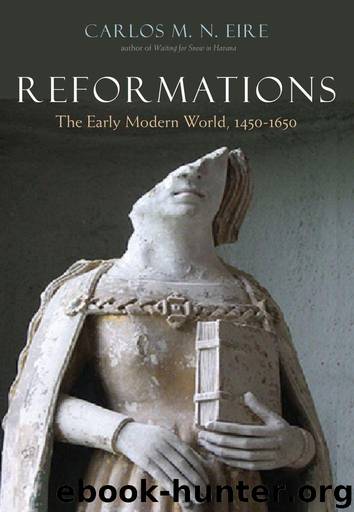Reformations: The Early Modern World, 1450-1650 by Eire Carlos M. N

Author:Eire, Carlos M. N. [Eire, Carlos M. N.]
Language: eng
Format: azw3
Publisher: Yale University Press
Published: 2016-06-27T16:00:00+00:00
Drastic choice. A key meditation in the Spiritual Exercises of St. Ignatius concerns the proposition that one cannot avoid choosing between God and devil, or, as Ignatius puts it, between the battle standard of “Christ, our Commander-in-chief and Lord” and that of “Lucifer, mortal enemy of our human nature.” This meditation on the two standards stresses both the freedom of the will and the absolute necessity of prayer, grace, and divine guidance.
The central significance of the Exercises for the development of Jesuit spirituality lies not in its tempered dualism, but in its worldly asceticism,8 which rivaled that of Calvinists, as it stressed the principle that the purpose of human existence is to find God in this world, become his “servant and friend” and work within the world to magnify God’s glory through selfless and humble service to others. In other words, as Jesuits came to see it, the world was a place to redeem rather than to run from, and leading a virtuous life was the best way to magnify God’s glory on earth, an insight that became so central to their ethos that it was turned into a motto: ad maiorem Dei gloriam (for the greater glory of God). This commitment would provide the Jesuits with great zeal and a flexibility that allowed them to adapt their ministry to many different environments. That willingness to stretch should never be mistaken for license. The Jesuits remained doggedly faithful to the Catholic tradition while being innovative. This commitment to the historical and hierarchical nature of Catholicism was summed up by Ignatius in an appendix to the Exercises titled “Rules for Thinking, Judging, and Feeling with the Church.” These eighteen rules were a summation of Catholic theology and ethics, a creed of sorts. Behind each rule, as if on its horizon, one can easily make out everything that Protestants have rejected, and the first rule sums up the Jesuit approach succinctly:
With all judgment of our own put aside, we ought to keep our minds disposed and ready to be obedient in everything to the true Spouse of Christ, Our Lord, which is our Holy Mother, the Hierarchical Church.
The thirteenth rule expands on the first, but in such a pointed way that it would become emblematic of the Jesuit ethos, as controversial as the order itself and the very measure of what made Jesuits so formidable and so frightful to their enemies:
To keep ourselves right in all things we ought to hold fast to this principle: What I see as white, I will believe to be black if the hierarchical Church thus determines it.9
The development of the Jesuit ethos—or as they themselves called it “our way of proceeding” (noster modo procedendi)—is inseparable from the Exercises, for it was through the Exercises, even before they were in written form, that Ignatius recruited and trained his first followers, who in turn, with all who joined them too, would administer the Exercises to other potential recruits and to the laity they served. Undergoing the Exercises was
Download
This site does not store any files on its server. We only index and link to content provided by other sites. Please contact the content providers to delete copyright contents if any and email us, we'll remove relevant links or contents immediately.
| Africa | Americas |
| Arctic & Antarctica | Asia |
| Australia & Oceania | Europe |
| Middle East | Russia |
| United States | World |
| Ancient Civilizations | Military |
| Historical Study & Educational Resources |
Room 212 by Kate Stewart(4741)
The Crown by Robert Lacey(4574)
Endurance: Shackleton's Incredible Voyage by Alfred Lansing(4508)
The Iron Duke by The Iron Duke(4124)
The Rape of Nanking by Iris Chang(4024)
Killing England by Bill O'Reilly(3899)
Joan of Arc by Mary Gordon(3786)
Say Nothing by Patrick Radden Keefe(3726)
I'll Give You the Sun by Jandy Nelson(3274)
Shadow of Night by Deborah Harkness(3177)
Hitler's Monsters by Eric Kurlander(3164)
Mary, Queen of Scots, and the Murder of Lord Darnley by Alison Weir(3068)
Blood and Sand by Alex Von Tunzelmann(3060)
Darkest Hour by Anthony McCarten(3019)
Margaret Thatcher: The Autobiography by Thatcher Margaret(2972)
Eleanor & Park by Rainbow Rowell(2944)
Red Famine: Stalin's War on Ukraine by Anne Applebaum(2816)
Book of Life by Deborah Harkness(2721)
The One Memory of Flora Banks by Emily Barr(2685)
